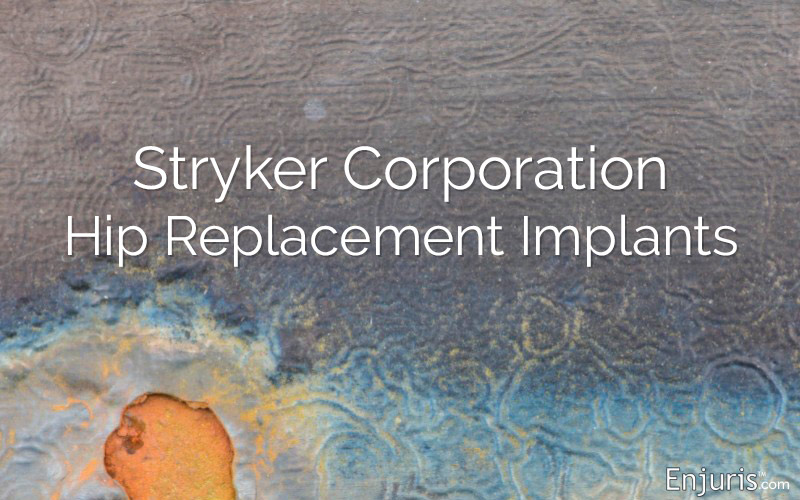
Which hip implants end in revision surgery
Stryker Corporation began in the 1940s as a small company in rural Michigan. Now, they market almost 60,000 products worldwide and are a leader in the medical device industry. Approximately 13% of their income is from hip replacement devices.
Most of their products are extremely successful and don’t receive complaints from patients.
However, two of their popular hip replacement implants used a proprietary metallic blend, and that is where problems started.
Stryker’s issues arose because of their metallic blend, TMZF (titanium, molybdenum, zinc and iron). They stated that this blend reduced the chance of corrosion or fretting in devices, which is when small particles break off the implant inside the patient.
Unfortunately, post-market data showed that there were still many, many instances of corrosion and fretting. The most significant problems were osteolysis (inflammation that leads to the loosening of an implant) and metallosis (shedding of metal particles that build up in soft tissue, usually ending in blood poisoning). See more on metallosis after hip surgery.
 Post-Accident Journal Form
Post-Accident Journal Form
Sample accident journal/diary to help you document the effect on your daily life
Download in PDF format![]()
This discovery made the company recall two of its most popular products that contained the TMZF alloy, and the number of lawsuits concerning these devices blew up.
Stryker Corporation lawsuits
Defective products lawsuits fall into one of three buckets:
- Manufacturing defect: The end product was not safe to use, even though it was designed as such. If that end product causes an injury to its user, the manufacturer can be held liable.
- Failure to warn: These supply chain issues are called “marketing defects.” The product was designed as intended, but it did not supply the right warnings or instructions. This makes the product unreasonably hazardous to its end users.
- Design defects: Even if it was made according to its design, that end product contains defects that can still endanger people. A product can be unreasonably dangerous if it does not perform as expected when used it in its intended manner.
Metal-on-metal implants such as Stryker’s ABG II or Rejuvenate would qualify as “design defects.” They endangered the health and safety of the end user. Even when used as intended, they can shed particles that build up in soft tissue or cause inflammation that makes the implant loosen from the socket.
The interesting thing about Stryker’s implants was that they didn’t resemble other metal-on-metal devices on the market. Other companies preferred a single stem attaching to a solid base, which was called a “monoblock” device; Stryker’s ABG II had up to eight right stems, eight left stems and 10 modular necks. This arrangement was supposed to offer greater stability and cause less bone stress. The Rejuvenate system, meant for younger patients, had six stems and 16 necks. This meant that surgeons could custom-fit the device to each individual patient.
Curiously, the defects within these two devices were not of the typical variety, meaning that they weren’t ball-in-socket devices that rubbed against each other. What happened with Stryker’s implants was that the necks contained chromium and cobalt, which rubbed against titanium coating on the stems; this led to particle shedding.
Recalls of Stryker Corporation devices
After learning about the particle shedding, Stryker permanently recalled both the ABG II and the Rejuvenate models from the market between the years 2009 and 2013.
Thousands of patients still ended up suing them, because the shedding led to swelling, inflammation, increased pain and local tissue damage. Many needed revision surgeries to fix the problem. Stryker ended up paying out $1.43 billion in 2014 to thousands of plaintiffs from 39 states, settling early in the litigation process to avoid going to court. Any patient who received hip implant surgery prior to November 3, 2014 was eligible to participate in the claim, and payouts to each plaintiff were approximately $300,000.
Those aren’t the only implants with the proprietary TMZF blend, however. There are still plenty of products on the market that use those metals in conjunction, such as the Accolade, Meridian and Citation hip components. Stryker claims that pairing the metal with ceramic femoral heads rather than chromium cobalt femoral heads makes particle shedding far less likely.
Additionally, they also aren’t the only implants recalled for various reasons, such as not meeting company standards in post-market tests or patient concerns:
Stryker Orthopedics hip implants recalled:
- Rejuvenate
- ABG II
- Omnifit
- Sulzer Inter-Op
- Exeter
- Crossfire
- Trident Hemispherical SH
ConsumersUnion published a Summary of Hip Implant Recalls in 2013 that looked at recalls from the major hip implant device manufacturers: Zimmer Biomet, DePuy, Smith & Nephew, Wright – and Stryker.
Here’s what the report said about Stryker:
Out of all the companies, Stryker has recalled the most hip devices in the last decade: 178 Class II recalls and 53 Class III recalls, which are likely to cause serious and life threatening harm to patients. Stryker recalled the hip devices/ tools because of:
- Fracturing: surgical instruments (broach and rasp handle11) used to size the femur for the implant, may fracture during a surgery; hip stem demonstrated fractures
- Cracking: hip stem coating may crack
- Labeling Issues: the sizes of different implant components were mislabeled, which may lead to an incorrect implant being used; device components had incorrect expiration date; instructions for the femoral stem were not labeled
- Manufacturing Issues: acetabular shells too thick; acetabular shells have different thicknesses which can increase the gap between the shell and liner causing “interference”; hip stems didn’t meet specifications for strength; components used for hip implants were made with a raw material that were not up to standards; “exceeded foreign materials standards”
- Packaging Issues: the sterility of the hip stem may be compromised because of poor packaging; the package of implant components had a “visual defect”; 16mm stem in 18mm stem package
What should I do if I think I have a defective Stryker hip replacement implant?
You might not know exactly what implant you have inside of you; however, your surgeon will. While there isn’t a national registry of devices in the United States for consumers to access (yet), at the very least your surgeon can review your medical records to confirm your suspicions. Then, search online to see if that implant corresponds to a hip replacement recall. You can set up a Google alert for “Stryker hip replacement recalls” and it will bring up every result for you on a daily basis. (How to set up a Google Alert.)
Keep an eye on your surgical site and visit your surgeon for a checkup at least once a year. If there is pain, inflammation or other unusual symptoms, meet with your doctor as soon as possible.
If you believe your device is defective, reach out to an attorney – quickly. You don’t want to file outside of the statute of limitations for your case. (This is the length of time in which you can file a claim, and it varies by each state.)
 Personal Injury Attorney Interview Sheet
Personal Injury Attorney Interview Sheet
Worksheet with questions to ask a personal injury attorney to help determine if he or she will be a good fit for your case
Download in PDF format![]()
Most importantly, remember that you don’t have to do this by yourself. Check out the Enjuris law firm directory to find legal representation and learn more about what kind of lawyer you will need.
- Hip Replacement Surgery
- DePuy Orthopaedics Hip Replacement Devices
- Hip Replacement Complications
- Hip Replacement Lawsuits
- Hip Replacement Surgery Overview
- Metallosis from Hip Replacement Devices
- OMNIlife Hip Replacement Lawsuits
- Recalls for Hip Replacement Devices
- Smith & Nephew Hip Replacement Devices
- Stryker Orthopedics Hip Replacement Recalls and Lawsuits
- Wright Medical Hip Replacement Devices
- Zimmer Biomet Hip Replacement Recalls and Lawsuits
See our guide Choosing a personal injury attorney.
